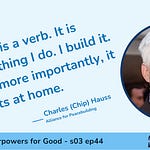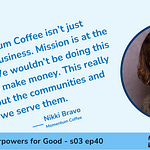Remember, you can watch the Superpowers for Good show on e360tv. To watch the episode, download the #e360tv channel app to your streaming device–Roku, AppleTV or AmazonFireTV–or your mobile device. You can even watch it on the web.
Devin: What do you see as your superpower?
Richard: We are trained–this is what I have used–what is called inductive reasoning. In inductive reasoning, what happens is you're given a solution, and you say, “Now, what problem can I solve with this?” That's upside-down thinking to a lot of people. But it's what we've been able to do–what I've done with everything, every new technology that's landed on my desk. I pick it up and go, “Wow! I don't know what the heck to do with this, but I'm going to try to find something.”
Archimage founder and President Richard Buday built an architectural firm that used the skills and technologies of architecture to create visually appealing and educational video games.
He explains how this happened:
I've often had this discussion with other architects who say, “Richard, looks like you're having a lot of fun, but it's not architecture.”
In fact, it is architecture. My firm began in 1983 under another name. We were early adopters of computers at that time. It was computer-aided design or computer-aided drafting, and we were just coattailing onto what was called the computers and architecture revolution at the time.
As we were early adopters, we were getting the attention of new software companies, one of which was Autodesk. We knew the original founders of that company, and we became early alpha and beta test sites for a lot of their products, including their animation software.
One thing led to another and 20 years into our almost 40-year history, we were doing video games. That's the short story, but it's still architecture.
Here’s a promo video for one of the games Archimage created.
In Richard’s work, he honed his ability to use inductive reasoning, making it a superpower.
AI Episode Summary
1. Richard Buday is the founder and president of Archimage, an architectural firm that has ventured into video gaming.
2. Richard's firm was an early adopter of computers in architecture, which caught the attention of companies like Autodesk. This led to their involvement in animation software and, subsequently, video gaming.
3. Archimage developed "serious video games" with Baylor College of Medicine to promote healthy behaviors, including a game designed to assist single-parent moms with children's eating and exercise habits.
4. Richard reflects on architecture's role in society and advocates for incorporating narrative transportation theory into building design, making architecture more meaningful and communicative.
5. Discussing the dangers of aging condo buildings, specifically high-rises, Richard points to the collapse of a tower in Florida as a symptom of homeowner association boards failing to address necessary repairs and maintenance due to psychological and social dynamics.
6. Richard writes about various topics, including the challenges of maintaining aging condominiums and their reliance on homeowner boards for critical decision-making and funding.
7. He sees his superpower as the ability to apply inductive reasoning: taking a solution and finding problems it can solve. This has allowed him to explore new directions in technology and architecture.
8. Richard advises others to learn inductive reasoning skills and understand narrative transportation theory, which can powerfully influence behaviors for good or ill.
9. To read Richard's writings on architecture and his views on persuasive design, he directs readers to Common Edge.org, where most of his articles are published.
10. Richard Buday can be reached for further discussion and inquiries about his work through his email at rbuday@archimage.com and his website archimage.com. He is open to engaging with interested individuals on relevant topics.
How to Develop Inductive Reasoning As a Superpower
Richard shared a story to illustrate how he used inductive reasoning to full effect during his remarkable career:
We were working on Buena Vista's work for Walt Disney. Of course, Disney has its own animators. But we were brought in because we had an architect's eye that we could apply to the animation that was needed for those kinds of projects.
But our whole path from standard architectural planning and designing, working with buildings and interiors to virtual environments–cities, societies living inside of a computer–came about because we were trying to find ways to apply our new technology to new kinds of projects.
After a while, we started thinking along those lines. We had a tagline for the firm for many years called “Designing what's next.”
By following Richard’s example, you can make inductive reasoning a skill that enhances your work. With practice, you could hone it into a superpower that enables you to do more good in the world.
Remember, however, that research into success suggests that building on your own superpowers is more important than creating new ones or overcoming weaknesses. You do you!
Guest Profile
Richard Buday (he/him):
President, Archimage
About Archimage: Archimage clients include Baylor College of Medicine, Compaq Computer Corporation, IBM, Knowledge Adventure, Nintendo, Northwestern University, the National Cancer Institute, the Texas State Education Agency, The University of Texas Health Science Center at Houston, The Walt Disney Company, Time Warner Communications, and Ziff-Davis Communications.
Website:
https://www.Archimage.com
Other URL: https://en.wikipedia.org/wiki/Archimage
Biographical Information: Richard Buday, FAIA, is an architect, writer, educator, and member of the College of Fellows of the American Institute of Architects. He co-founded Buday Wells Architects in 1983, which became Archimage in 1990. The digital arts studio won more than 40 design awards during its 33-year run, from buildings and interiors to short films, broadcast television commercials, illustration and graphics, websites, and interactive media. Today, Richard is applying lessons learned in researching and developing health video games to architecture theory.
Richard was an early pioneer in computers in architecture, teaching digital graphics at the University of Houston College of Architecture for more than ten years and publishing on new media in design. He co-authored the American Institute of Architects CAD Layer Guidelines, which is now part of the US National CAD Standards. Richard began research on the use of entertainment technology for teaching, training and improving health behaviors in the 1990s, serving as a collaborator and as Principal Investigator of numerous National Institutes of Health grants.
He has shared his research through more than 90 articles in magazines, refereed scientific journals, and edited books, leading to invited lectures at over 100 national and international conferences and symposia. He also co-authored a novella for middle-school-age children, novels for parents of young children, and an ethics course for health profession students written in the form of a choose-your-own-adventure story. He continues publishing articles on architecture and behavior.
Articles about Richard, Buday Wells Architects, and Archimage have appeared in U.S. News & World Report, The Financial Times, Washington Post, USA Today, Boston Globe, ID Magazine, Architecture, Progressive Architecture, Architectural Record and broadcasts on CBS, ABC, Pacifica, and National Public Radio. Archimage clients include Baylor College of Medicine, Compaq Computer Corporation, IBM, Knowledge Adventure, Nintendo, Northwestern University, the National Cancer Institute, the Texas State Education Agency, The University of Texas Health Science Center at Houston, The Walt Disney Company, Time Warner Communications, and Ziff-Davis Communications.
Linkedin: https://www.linkedin.com/in/richard-buday-faia-54b2342/
















